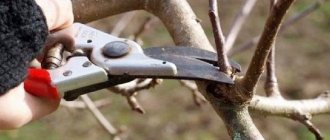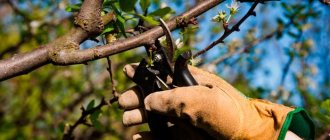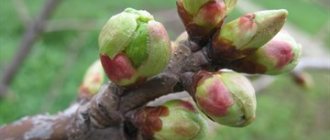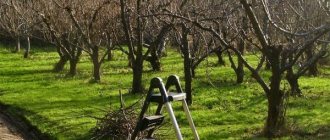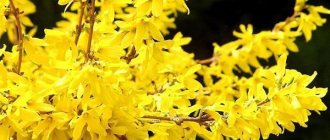Forsythia is one of the most beautiful ornamental shrubs that will delight you with its colorful colors.
In spring it turns golden, strewn with yellow flowers, in summer it is covered with thick green foliage, which turns purple in autumn. Given the rapid growth rate of the crop, one of the most important procedures is pruning forsythia in the spring. It helps prevent thickening of the bush, because forsythia grows many young shoots over the course of a season. In addition, pruning stimulates annual and lush flowering, and this crop has its own characteristics. It blooms in early spring, when most garden plants are just beginning to bloom leaves. And the flowers themselves bloom only on last year’s shoots. On young growth and branches older than 2 years, flower buds do not form. If you do not prune the bush, over time the flowering will move only to the periphery, and most of the crown will be without buds.
When to prune
Regular removal of non-viable and excess sections is required due to the fact that the bush is a fast-growing one. Its dimensions reach 2 m in width and 3 m in height, but these are too large for growing in the garden. Therefore, the diameter is reduced to 1.5 m.
Appearance of a forsythia bush
You need to know when to prune forsythia so as not to harm the plant. For the first 3-4 years, active pruning of bushes is not required. The plant must be given the opportunity to grow and become stronger. Then solving the problem of when to cut forsythia is carried out in 2-3 stages. The pruning scheme involves 3 types of haircuts: first, regular and rejuvenating. They differ in regularity and in the amount of material removed.
The first time pruning is carried out in March-April, even before the leaves appear, in the second year after planting. It is visually easy to identify dry and damaged parts; active sap flow has not yet begun. The first cutting of forsythia involves the almost complete removal of shoots, leaving a few of the strongest ones.
The main correction is carried out in the spring, after flowering. In the summer, the bush will have time to recuperate. Additionally, the procedure can be carried out in the fall, but this pruning does not determine the intensity of growth and flowering of the bush next year.
Attention! Correction of the bush is possible during flowering only if the plant is sick, neglected or has many damaged shoots. During the active period, the bush is most vulnerable, so you should compare the harm from pruning with the harm from damage. If you can wait until the end of the period, then you should abstain.
Stages of formation of a forsythia bush
According to the standard, the next stage is pruning the forsythia after flowering. You should not cut off many shoots at once, this will have a negative impact on the condition of the bush. Therefore, care is required throughout the year.
Description of forsythia
All existing species belong to the Olive family, with similar characteristics. Externally, the plant resembles a shrub with yellow flowers. It reaches a height of 1-3 m. The leaves are oval in shape, 15 cm long; during flowering, small bell-shaped flowers appear. Inflorescences are few-flowered. The color can be very diverse: from light yellow tones to dark orange.
Flowering continues until the leaves begin to bloom, and lasts 20-40 days. The fruits resemble an elongated capsule with winged seeds. The shrub loves light and is quite unpretentious. Today, there are several dozen varieties that differ in characteristics, size and color.
Important! In winter, if the birds do not have enough food, they can peck the buds, thereby harming the forsythia.
Pruning rules
What to do when the tips of dracaena leaves dry out
Having decided when to prune forsythia, you should consider how to properly form the bush, when to prune the branches and how. For work you need to use a sharp tool, pruning shears and a garden saw. They should leave an even cut. The metal is pre-disinfected with an antiseptic.
It is important to know! To protect the plant from ultraviolet rays and pathogenic flora, procedures are carried out on a cloudy day, or even better in the rain.
The instructions imply a step-by-step sequence of actions:
- Getting rid of shoots that make the bush thick.
- Shortening of new shoots that have begun to grow.
- Pruning shoots that have already faded.
- Complete removal of dry and diseased shoots.
When refining a bush, branches that are low above the ground or those that touch it are removed. Similarly, shoots that grow inward or come into contact with other shoots are destroyed.
While working, you need to know how long to shorten the arrow. Young branches that have already bloomed are shortened by 50% in the summer. If damaged shoots are found, they are removed to a level of 6-7 cm from the ground.
There is such a thing as anti-aging pruning. This is caring for a bush in 2 stages over 2 years. The first year, all old shoots are eliminated, leaving no more than 5 main ones. Next year, when the bush produces many young shoots, you need to remove the remaining old ones. The remaining young ones are shortened so that they begin to branch.
Stages of bush formation
Diseases and pests of forsythia
Despite the fact that forsythia is resistant to pests and diseases, there is a possibility of fungus. When a fungal disease occurs, small growths appear on the bush that resemble warts. Since this disease is practically incurable, the bush must be completely removed and another one planted.
If small spots appear on the leaves, then it is necessary to treat the forsythia with a solution of copper sulfate. During the wilting of the bush, captan or foundation is used. You can also degrease the soil using a carbocation.
Often lethargy appears due to rotting of the root system. To prevent this disease, it is recommended to establish an irrigation system. It is recommended to water the plant once every 3 times.
Advice! In some cases, you can dig up the forsythia, remove the damaged roots and replant.
How to form a bush
How to prune roses for the winter - when is the best time to do it?
The formation of forsythia is required not only for the timely removal of old and diseased shoots. Another goal of the procedure is to preserve the decorative appearance of the bush. Formation begins from the 2nd year of shoot growth. Excess shoots are strictly monitored, cutting off the excess immediately so that the stem does not bend. Avoid pruning many units at once so as not to make the bush visually bare and weaken it before winter.
It is given different shapes: cone, sphere, parallelepiped. These are easily reproducible options that do not require a lot of imagination and effort. Which one is better to choose depends on the type of crown: weeping, hanging, regular, with a vertical orientation.
The plant is often used to create a hedge. If this type of molding is planned, then the plant is not touched for 2-3 years. During this time, the shoots gain strength, the stem thickens, and the sprouts intertwine with each other. Forsythia is pruned in the shape of a rectangle or trapezoid. There are a number of requirements for a hedge: it must be thick inside and strong, but let light inside.
The task of how to form forsythia depends on the chosen option for the appearance of the bush. If the crown is natural, then you need to produce the main part once every 3 years and preventatively annually.
To give the shape a pyramid or trapezoid, you need to trim the shoots according to the desired pattern in the second year. After the first pruning, the shape is adjusted 2 times a year: in the spring the main part, in the fall slightly.
Shortening forsythia shoots
Forsythia is formed into a ball in several ways. The first is to shorten all shoots to the same length every year. The second is cutting the shoots according to the chosen shape. The method requires compliance with the geometry of the structure so that the bush does not look careless. It is not necessary to cut the stems to give it shape; you can simply bend the shoot.
Attention! Before you start shaping, you should study the information on how to trim forsythia. Otherwise, you can end up with a bare bush with poor lighting and dry shoots.
Features of planting and caring for forsythia in Siberia
If you plan to plant forsythia in Siberia, then it is necessary to provide the shrub with proper care, this is the only way the plant will delight with its appearance. In Siberia, forsythia is planted in places with little shade. It is also necessary to ensure that the site chosen for planting is protected from the wind. Often shrubs are planted near buildings or trees.
Soil enriched with microelements is ideal; humus is usually used for these purposes. Stagnation of moisture is not allowed, so the soil must be loose and well-permeable to air. If the soil is acidic or heavy, then it should be prepared in advance for planting forsythia.
Attention! If you do not provide proper care and allow groundwater to stagnate, the forsythia may die.
Care after pruning
After the crown has been formed as a result of spring care, forsythia is fed and the roots are ennobled. Immediately after winter, the bush is mulched with humus and then watered.
Pruning jasmine after flowering and to form a bush
When the shoots become covered with buds, mineral fertilizers are applied, and after flowering - nitroammophoska and selenium. At the end of summer, the bush needs potassium and phosphorus. During the warm period, there is a need for careful control of soil moisture. If precipitation occurs frequently, then additional watering is not needed. In dry weather, the soil is moistened.
After autumn pruning, moisten the substrate where the forsythia grows, insulate the roots with pine needles and rotted leaves in a volume of 10 cm.
Attention! If you properly fertilize and insulate the plant, this will give it the strength to survive the winter and bloom next year.
If the bush does not bloom in the spring after the autumn growth correction, this is not necessarily due to incorrect technology. Perhaps the optimal planting location for forsythia has not been selected, or fertilizers have not been applied in a timely manner. The bush loves places with good lighting, but without excess moisture.
Features of planting and caring for forsythia in the Urals
For each region, there are certain conditions for growing shrubs, so it is necessary not only to familiarize yourself with the photo of forsythia, but also with the rules of planting and care in the Urals. In the Urals, shrubs are planted in light soil, which is rich in humus and leaf soil. To lighten the soil, you can use expanded clay or river sand. It is important to understand that forsythia does not tolerate acidic soils.
The planting depth is about 70 cm, drainage up to 20 cm high is laid at the bottom of the hole, for this they use:
- broken building bricks;
- middle fraction expanded clay;
- sand.
To make the shrub grow faster, use top dressing and fertilizers, which are applied in the spring. Forsythia loves dry soils, so it is not recommended to overwater it.
Advice! The distance between bushes should be 2 m.
Possible problems
With proper care and all agrochemical measures (watering, loosening the soil, pruning, proper organization of wintering), forsythia will certainly delight the gardener with early, abundant flowering. If this does not happen, it means that some procedures were not carried out in a sufficiently timely manner, the rules were not strictly followed, or the plant became “sick.” There are not many diseases in Forstaitia. Most often, the problem is caused by excessive watering, while the shrub easily tolerates drought. If the soil is very waterlogged, then the best option would be to loosen it, which will lead to the rapid removal of moisture from the soil. Other common diseases include the following:
In order to promptly detect the disease, the plant must be periodically inspected. In most cases, damaged shoots are simply removed, and healthy ones are treated with special preparations and fungicides. Forsythia also does not have many pests. Most often, aphids attack the bush. A colony of these small but prolific insects can slow down the development of forsythia. To control pests, they use pest control agents or use traditional methods.
Thanks to its early, abundant flowering and bright, sunny color, landscape designers widely use forsia for landscaping parks and squares. Original compositions can be created from forsythia and evergreen trees and shrubs (periwinkle, boxwood) planted together to form a hedge.
Reproduction methods
Today, various online stores offer a wide selection of forsythia seedlings, but many gardeners prefer to grow it themselves. There are three ways to propagate shrubs: seeds, layering and cuttings.
- Seeds
This method is quite complicated, especially since self-collected material has low germination; only 30% of the seed germinates. Therefore, you need to purchase forsythia seeds only from trusted manufacturers. Sowing is carried out in March, in special containers for germination filled with nutritious soil. To avoid rapid drying of the soil surface, they are covered with glass and periodically moistened with a spray bottle. After 4-6 weeks, when the first shoots appear, the glass is removed. After the first two leaves appear, they are picked, planted in protected soil (greenhouses, greenhouses, greenhouses). The seedlings are transplanted to a permanent location in the fall, if necessary, protecting them from exposure to low temperatures.
- By layering
- Cuttings
- bacteriosis;
- moniliosis;
- rapid wilting of inflorescences.
This method is the simplest and least labor-intensive, so it is most often recommended for beginning gardeners. In the spring, last year’s most flexible shoots, after slightly cutting the bark, are tilted and carefully “pinned” with the cut to the soil, covered with a layer of soil. The plant is watered intensively. Soon, roots will begin to form at the incision site. Over the summer, the new plant will develop a root system, and young shoots will appear on top. After this, the young plant is carefully separated from the mother bush with a sharp knife or pruning shears and transplanted into the prepared hole.
To obtain planting material, only healthy shoots with well-formed buds are used. Cuttings 15-18 cm long are cut from them. Before planting, they are dipped in a container with a solution of root or other growth stimulant for a day. In a place protected from bright sun and drafts, lightly loosen the soil, moisten it, or use special containers with moist soil. The cuttings are buried 5-10 cm into the soil, so that 2-3 buds are below ground level. Each cutting is covered with a glass jar trimmed with a plastic bottle. The plantings are periodically watered and ventilated in warm weather. After a month, roots, leaves and shoots should appear on the cuttings. If young plants are left in open ground for the winter, they must be covered. In spring, seedlings can be planted in a permanent place.
Required Tools
To trim shrubs, including its decorative dwarf varieties, you need a well-sharpened, sharp tool that should leave even cuts. Before and during cutting, it is important to disinfect the metal with suitable antiseptics. If you use a dull, dirty blade, fungus or other infection may develop at the cut site, which is dangerous for forsythia.
The main tools required for the work are garden pruners and a hand saw for wood or a lopper , shaped like scissors with long handles and considered the most convenient for such work. A hacksaw is needed if you decide to trim thick, large branches. Before the procedure, you should make sure you have a garden varnish: it is used to smear large cuts that form on shoots 1.5 cm thick. The cut material should not be thrown away: it can be useful as mulch, for high beds or compost. It is wiser to burn branches affected by the disease to protect the rest of the plants in the garden.
Pruning - both in spring and summer, and in autumn - should be carried out in the absence of sunlight, on a cloudy day, preferably during rain - this will eliminate ultraviolet burns and the penetration of pathogenic flora.


